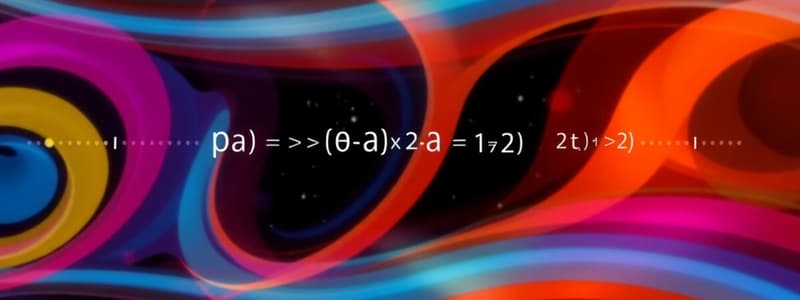Podcast
Questions and Answers
What type of problem does the knapsack problem represent?
What type of problem does the knapsack problem represent?
- Sorting problem
- Graph traversal problem
- Dynamic programming problem (correct)
- Linear programming problem
What is the main objective when constructing a binary search tree (BST) given n keys and their search probabilities?
What is the main objective when constructing a binary search tree (BST) given n keys and their search probabilities?
- Minimize the average number of comparisons in successful search (correct)
- Ensure all keys have equal spacing
- Maximize the height of the tree
- Maximize the frequency of search operations
If a binary search tree is constructed with keys in ascending order and equal probabilities, what is likely to happen?
If a binary search tree is constructed with keys in ascending order and equal probabilities, what is likely to happen?
- The tree will be perfectly balanced
- The performance of searches will be optimized
- The tree will have a constant search time
- The number of comparisons will be maximized (correct)
Which of the following is NOT an example of a dynamic programming algorithm?
Which of the following is NOT an example of a dynamic programming algorithm?
Which property of the keys directly influences the construction of the optimal binary search tree?
Which property of the keys directly influences the construction of the optimal binary search tree?
In the context of the knapsack problem, what is meant by finding the most valuable subset of items?
In the context of the knapsack problem, what is meant by finding the most valuable subset of items?
What is a defining characteristic of dynamic programming problems?
What is a defining characteristic of dynamic programming problems?
How does dynamic programming typically compute solutions?
How does dynamic programming typically compute solutions?
Which algorithm would be used to solve the traveling salesman problem?
Which algorithm would be used to solve the traveling salesman problem?
When trying to construct a binary search tree with minimum average comparisons, what is considered a key factor in the decision process?
When trying to construct a binary search tree with minimum average comparisons, what is considered a key factor in the decision process?
What is the outcome of combining the solutions of subproblems in dynamic programming?
What is the outcome of combining the solutions of subproblems in dynamic programming?
What is the expected outcome of a properly constructed binary search tree with respect to search operations?
What is the expected outcome of a properly constructed binary search tree with respect to search operations?
What does the variable 'W' represent in the context of the knapsack problem?
What does the variable 'W' represent in the context of the knapsack problem?
Which statement is incorrect regarding dynamic programming?
Which statement is incorrect regarding dynamic programming?
What method is used to derive solutions from subproblems in dynamic programming?
What method is used to derive solutions from subproblems in dynamic programming?
What is the mathematical formula used to calculate the total number of Binary Search Trees (BSTs) with n nodes?
What is the mathematical formula used to calculate the total number of Binary Search Trees (BSTs) with n nodes?
Why is brute force not an efficient method to calculate the number of BSTs as n increases?
Why is brute force not an efficient method to calculate the number of BSTs as n increases?
What search probability is assigned to key C in the example of an optimal BST for A, B, C, and D?
What search probability is assigned to key C in the example of an optimal BST for A, B, C, and D?
Given the keys A, B, C, and D with respective search probabilities of 0.1, 0.2, 0.4, and 0.3, which key has the lowest search probability?
Given the keys A, B, C, and D with respective search probabilities of 0.1, 0.2, 0.4, and 0.3, which key has the lowest search probability?
In the context of optimal BSTs, which of the following is typically a consideration when organizing nodes?
In the context of optimal BSTs, which of the following is typically a consideration when organizing nodes?
Flashcards
Dynamic Programming Overlapping Subproblems
Dynamic Programming Overlapping Subproblems
Dynamic programming problems involve subproblems that are repeated.
Bottom-Up Computation
Bottom-Up Computation
Dynamic programming solves smaller subproblems first, then combines them to solve the larger problem.
Subproblem Solutions Extraction
Subproblem Solutions Extraction
Dynamic programming gathers results from solved subproblems.
Combining Subproblems
Combining Subproblems
Signup and view all the flashcards
Dynamic Programming Solution
Dynamic Programming Solution
Signup and view all the flashcards
Knapsack Problem
Knapsack Problem
Signup and view all the flashcards
DP approach to knapsack
DP approach to knapsack
Signup and view all the flashcards
Knapsack capacity
Knapsack capacity
Signup and view all the flashcards
Item weights & values
Item weights & values
Signup and view all the flashcards
Optimal subset
Optimal subset
Signup and view all the flashcards
Binary Search Tree (BST)
Binary Search Tree (BST)
Signup and view all the flashcards
Minimum average comparisons
Minimum average comparisons
Signup and view all the flashcards
Successful search
Successful search
Signup and view all the flashcards
Probabilities (p1...pn)
Probabilities (p1...pn)
Signup and view all the flashcards
Sorted keys (a1...an)
Sorted keys (a1...an)
Signup and view all the flashcards
Search probabilities
Search probabilities
Signup and view all the flashcards
Brute force (BST)
Brute force (BST)
Signup and view all the flashcards
BST
BST
Signup and view all the flashcards
Key
Key
Signup and view all the flashcards
Study Notes
Dynamic Programming
- Dynamic programming is a technique for solving problems with overlapping subproblems.
- Subproblems often arise from a recurrence relating a solution to a given problem with solutions to its smaller subproblems.
- Dynamic programming solves each smaller subproblem once and records the results in a table.
- A solution to the original problem can then be obtained from the table.
- Applicability to an optimization problem requires the principle of optimality.
- This means an optimal solution to any instance is made up of optimal solutions to subinstances.
Examples of Dynamic Programming Algorithms
- Knapsack Problem: This combinatorial optimization problem involves finding the most valuable subset of items that fit within a knapsack with a given capacity. A dynamic programming approach is used to solve this issue.
- Optimal Binary Search Trees: Determining the optimal binary search tree for a given set of keys and search probabilities is solved using dynamic programming.
- Warshall's Algorithm: This algorithm computes the transitive closure of a binary relation or the existence of all paths between vertices in a directed graph.
- Floyd's Algorithm: This algorithm finds the shortest paths between all pairs of vertices in a weighted graph (with no negative-length cycle).
Optimal Binary Search Trees
- Can be used to implement dictionaries (searching, insertion, deletion). Finding the BST with the minimum average number of comparisons in successful searches.
- Using a brute force approach is not efficient as the number of possible BSTs increases exponentially with the number of nodes.
- A dynamic programming solution utilizes a recurrence relation to determine the minimum average number of comparisons.
Studying That Suits You
Use AI to generate personalized quizzes and flashcards to suit your learning preferences.




